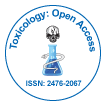A primer on Systematic Reviews in Toxicology
Received: 03-May-2022 / Manuscript No. tyoa-22-62869 / Editor assigned: 06-May-2022 / PreQC No. tyoa-22-62869 / Reviewed: 01-Jan-1970 / QC No. tyoa-22-62869 / Revised: 21-May-2022 / Manuscript No. tyoa-22-62869 / Published Date: 25-May-2022 DOI: 10.4172/2476-2067.1000180
Introductions
Systematic reviews, pioneered in the clinical field, provide a transparent, methodologically rigorous and reproducible means of summarizing the available evidence on a precisely framed research question. Having matured to a well-established approach in many research fields, systematic reviews are receiving increasing attention as a potential tool for answering toxicological questions. In the larger framework of evidence-based toxicology, the advantages and obstacles of, as well as the approaches for, adapting and adopting systematic reviews to toxicology are still being explored. To provide the toxicology community with a starting point for conducting or understanding systematic reviews, we herein summarized available guidance documents from various fields of application [1]. We have elaborated on the systematic review process by breaking it down into ten steps, starting with planning the project, framing the question, and writing and publishing the protocol, and concluding with interpretation and reporting. In addition, we have identified the specific methodological challenges of toxicological questions and have summarized how these can be addressed. Ultimately, this primer is intended to stimulate scientific discussions of the identified issues to fuel the development of toxicology-specific methodology and to encourage the application of systematic review methodology to toxicological issues [2].
Overall, these issues increase the risk that a review will produce misleading results through selective use and/or interpretation of the available evidence, and transmission of bias and error in the reviewed evidence to the final summary results. Lack of transparency in reporting of review methods can make it very difficult for the reader to detect such shortcomings. Given the numerous sources of potential bias, and the lack of transparency and methodological rigor, traditional “narrative” toxicological reviews are at an increased risk of being biased and often cannot be independently reproduced [3]. This makes it difficult to confirm a review’s conclusions and runs the risk of misdirecting future research. In worst cases, risk management decisions based ostensibly on the same evidence base may differ significantlyfor Bisphen for trichloroethylene, leading to a variety of issues, including uncertainty for all stakeholders. This undermines trust in decision makers’ and impedes consumers’ decision making, potentially jeopardizing public health. It should be noted, however, that notwithstanding their shortcomings for purposes such as summarizing toxicological knowledge or informing decision making, narrative reviews have their place in toxicology, e.g., when an expert view on a topic is needed or when time to make a decision is limited, as long as the nature of the review is made explicit. summarizes how various features differ between narrative and systematic reviews. While this summary provides a general overview and is in most features a relative comparison of the review types, it demonstrates that the rigor of systematic reviews often requires increased time and resources [4].
Conculsion
This primer is an introduction to the application of the systematic review process to toxicological issues. It is intended primarily for those unfamiliar with systematic reviews, who would like to understand them better and/or conduct their own. It draws on existing guidance from the fields of clinical medicine, environmental sciences, food and feed safety as well as the emerging guidance in toxicology. The existing guidance documents compartmentalize a systematic review into different numbers of individual steps. In this primer, a fine-grained approach to parsing the various review steps was chosen to deliver the information in succinct components. For each step, the most important aspects to be considered are highlighted. To summarize, our framework for a systematic review consists of ten steps and their associated topics
Acknowledgement
None
Conflict of Interest
None
References
- Balshem H, Helfand M, Schünemann HJ, Oxman AD (2011) GRADE guidelines Rating the quality of evidence. J Clin Epidemiol 401-406.
- Bero L, Anglemyer A, Vesterinen H, Krauth D (2015) The relationship between study sponsorship, risks of bias, and research outcomes in atrazine exposure studies conducted in non-human animals: systematic review and meta-analysis. Environ Int 597-604.
- Birnbaum LS, Thayer KA, Bucher JR, Wolfe MS (2013). Implementing systematic review at the National toxicology program: status and next steps. Environ Health Perspect A108-A109.
- Cedergreen N. (2014) Quantifying synergy: a systematic review of mixture toxicity studies within environmental toxicology. PLoS One e96-580.
Indexed at, Google Scholar, Crossref
Indexed at, Google Scholar, Crossref
Citation: White JK (2022) A primer on Systematic Reviews in Toxicology. Toxicol Open Access 8: 180. DOI: 10.4172/2476-2067.1000180
Copyright: © 2022 White JK. This is an open-access article distributed under the terms of the Creative Commons Attribution License, which permits unrestricted use, distribution, and reproduction in any medium, provided the original author and source are credited.
Share This Article
Open Access Journals
Article Tools
Article Usage
- Total views: 948
- [From(publication date): 0-2022 - Feb 23, 2025]
- Breakdown by view type
- HTML page views: 641
- PDF downloads: 307
